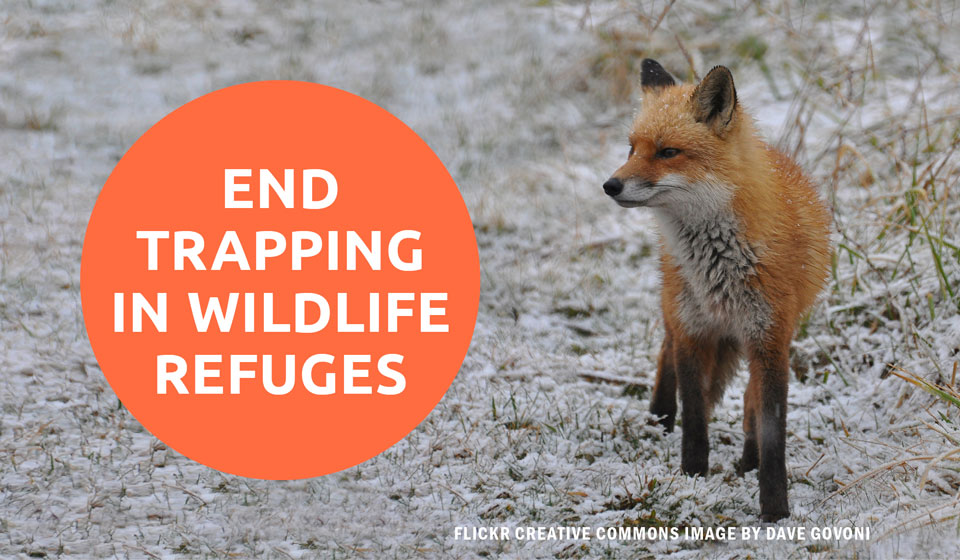Every year, countless animals suffer cruel fates at the hands of body-gripping traps such as strangling snares, Conibear traps, and steel-jaw leghold traps within the National Wildlife Refuge System (NWRS). On May 6, 2015, the Senate Environment and Public Works (EPW) Committee discussed the Refuge from Cruel Trapping Act (H.R. 2016/S. 1081) to consider prohibiting the use of harsh and indiscriminate body-gripping traps within the NWRS. Help us to end this punishing practice by showing your support and writing a letter to your representative.
The Problem of Body-Gripping Traps Within Our National Wildlife Refuge System
Almost 90 countries have banned the use of these traps, yet they are still allowed in the United States on federally “protected” land. Currently, animals living within National Wildlife Refuges are at risk of falling victim to indiscriminate body-gripping traps where they may suffer for hours or days—struggling to be free of the long-drawn-out pain inflicted on them by the traps. Many of these animals are killed for recreation and profit (fur)
Animals targeted by trappers include:
- Coyotes, bobcats, otters, fox, wolves, beavers, and raptors.
- Other victims of body-gripping traps include threatened and endangered species such as bald eagles, Canada lynx, and gray wolves.
These are the very animals the NWRS claims to protect. The NWRS encompasses the most comprehensive and diverse collection of fish and wildlife habitats in the world, and provides a home for more than 240 endangered species. National wildlife refuges are intended to be safe havens for wildlife, but in over half of the 563 national wildlife refuges, trapping is allowed. Millions of Americans visit refuges each year to hike on trails and observe a wide range of wildlife species in their natural habitats, and visitors should be able to enjoy these areas without fear that they or their pets may stumble upon a body-gripping trap or encounter an injured animal languishing in these gruesome devices.
The Refuge from Cruel Trapping Act Needs Your Support
A national Decision Research public opinion poll showed that 79 percent of Americans believe trapping on national wildlife refuges should be prohibited, while 88 percent believe wildlife and habitat preservation should be the highest priority of the refuge system. In order for our federal refuges to remain a sanctuary where all wildlife can live out their natural lives, we must be their voice and work together to pass the Refuge from Cruel Trapping Act to ensure they have the opportunity to do so.
Watch Senator Cory Booker’s remarks on trapping here (statement starts at 30:08) http://www.senate.gov/isvp/?type=live&comm=epw&filename=epw050615
What You Can Do:
1. Write to your U.S. Representative and urge him/her to support and co-sponsor the “Refuge from Cruel Trapping Act”(H.R. 2016 or S. 1081) to help restore the original intent of the National Wildlife Refuge System as a safe haven for wildlife by prohibiting the use of cruel body-gripping traps on this public lands system. SEE POINTS BELOW
Address your letters to:
The Honorable [Full Name]
U.S. House of Representatives
Washington, DC 20515
To find out who your Representative is go to www.house.gov/house/MemberWWW_by_State.shtml. Telephone and fax numbers of individual members of Congress can also be reached by calling Federal Information at (800) 688-9889.
2) Personalized written letters have a greater impact when writing to members of Congress. However, if you are pressed for time, you can send an email letter to your Representative through the Animal Welfare Institute’s website.
POINTS TO INCLUDE IN YOUR LETTER:
- Currently, animals living within NWRs are at risk of falling victim to body-gripping traps where they may be tortured for hours or days—struggling to be free of the long-drawn-out pain inflicted on them by the traps.
- Animals targeted by trappers include coyotes, bobcats, otters, fox, and other wildlife. Many of these animals are killed for recreation and profit (fur).
- Because body-gripping traps and snares do not discriminate, they jeopardize the very birds and threatened and endangered species refuges are supposed to protect.
- A national Decision Research public opinion poll showed that 79% of Americans believe trapping on National Wildlife Refuges should be prohibited, while 88% believe wildlife and habitat preservation should be the highest priority of the refuge system.
- Trappers, who compromise less than one tenth of 1% of the population, already have access to millions of acres of public and private lands outside the refuge system for their activities.
- The Refuge from Cruel Trapping Act will ensure our National Wildlife Refuge System —which was specifically set aside to provide animals a safe home — is maintained as an inviolate sanctuary for wild animals.
For more information on cruel and inhumane trapping methods, visit AWI’s website.
Please be sure to share this alert with family, friends and co-workers, and encourage them to contact their senators and representatives, too. As always, thank you very much for your help!

